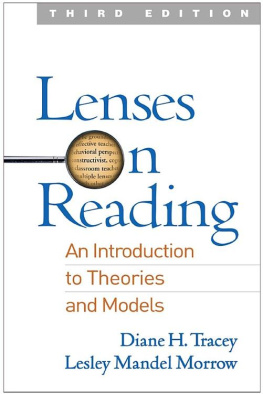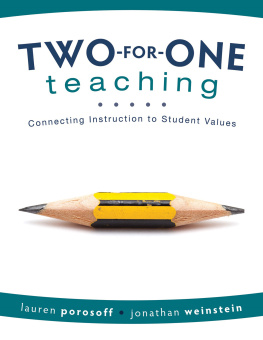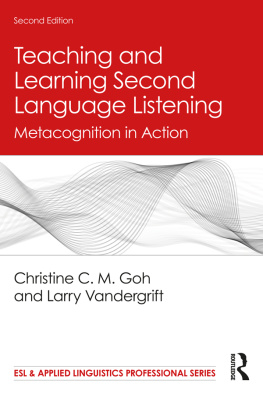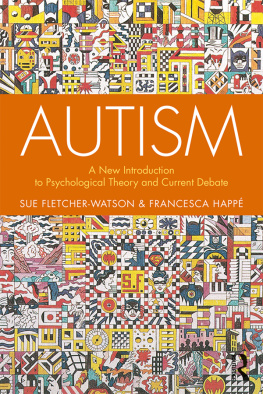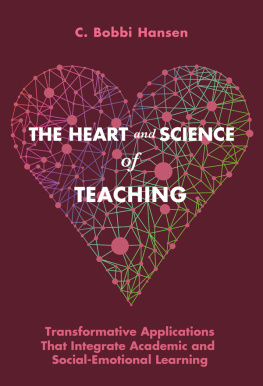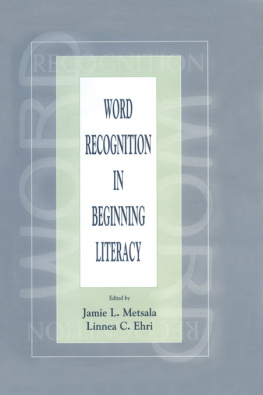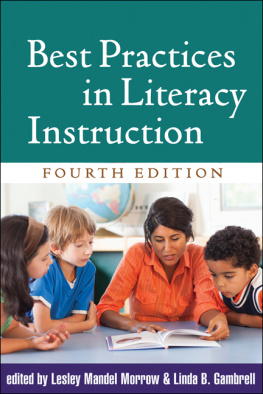Best Practices in Literacy Instruction, Fifth Edition
Edited by Linda B. Gambrell and Lesley Mandel Morrow
Lenses
on Reading
An Introduction
to Theories
and Models
THIRD EDITION
Diane H. Tracey
Lesley Mandel Morrow

THE GUILFORD PRESS
New York London
Epub Edition ISBN: 9781462530670; Kindle Edition ISBN: 9781462530687
Copyright 2017 The Guilford Press
A Division of Guilford Publications, Inc.
370 Seventh Avenue, Suite 1200, New York, NY 10001
www.guilford.com
All rights reserved
No part of this book may be reproduced, translated, stored in a retrieval system, or transmitted, in any form or by any means, electronic, mechanical, photocopying, microfilming, recording, or otherwise, without written permission from the publisher.
Last digit is print number: 9 8 7 6 5 4 3 2 1
Library of Congress Cataloging-in-Publication Data is available from the publisher.
ISBN 978-1-4625-3064-9 (paperback)
ISBN 978-1-4625-3065-6 (hardcover)
To my father, Hank Hirschmann (19262015): may your memory be a blessing to all who knew you.
And to my grandson, Benjamin Loizeaux Swain (2014): may your life be filled with great happiness and love.
D. H. T.
To Diane H. Tracey, my dear friend.
Thank you for allowing me to be a part of your wonderful book.
With love and friendship...
L. M. M.
Diane H. Tracey, EdD, is Professor of Education at Kean University. She has written widely on topics related to literacy achievement and is an active presenter at local, state, and national conferences. Dr. Tracey has served as Secretary of the Literacy Research Association and on the editorial review boards of the Journal of Literacy Research, The Reading Teacher, the National Reading Conference Yearbook, and Education and Urban Society. Currently, she is coeditor of the Journal of School Connections. Dr. Tracey is a recipient of Kean Universitys Presidential Scholars Challenge Award. Prior to her work at the university level, she was an early childhood educator and a research assistant on a large, federally funded grant project studying childrens reading disabilities. Dr. Tracey is also a graduate student at the Center for Modern Psychoanalytic Studies, training to become a modern psychoanalyst.
Lesley Mandel Morrow, PhD, is Distinguished Professor and Director of the Center for Literacy Development at the Graduate School of Education at Rutgers, The State University of New Jersey. A former classroom teacher and reading specialist, her research deals with multiple topics in early literacy development. Dr. Morrow has more than 300 publications, including journal articles, chapters, monographs, and books. She is a recipient of Excellence in Research, Teaching, and Service awards from Rutgers; the Outstanding Teacher Educator in Reading Award, the Special Service Award, and the William S. Gray Citation of Merit from the International Literacy Association (ILA); the Alumni Award for Outstanding Achievement from Fordham University; and the Oscar S. Causey Award from the Literacy Research Association. Dr. Morrow has served as president of both the ILA and the Reading Hall of Fame.
Lenses on Reading: An Introduction to Theories and Models, Third Edition, is an introductory text that offers an overview of the major theories and models regarding the reading component of literacy learning. The objectives of the text are to summarize key theories and models that shape our thinking about reading processes and instruction, and to provide our readers with implications and ideas for both practice and research. The ultimate goals of the text are to help educators enhance their instruction through better understanding of theories and models, and to assist researchers and graduate students in situating their research within theoretical frameworks. The book is designed for use as a text in graduate courses such as Foundations of Reading, Psychology of Reading, and reading research seminars. The volume should also prove useful as a reference and resource tool for personal and professional libraries.
PRINCIPAL THEMES AND UNIQUE FEATURES
The principal theme of the book is that there are myriad perspectives and viewpoints (lenses) that can be used to examine all of lifes circumstances. It is suggested that the more lenses through which individuals are able to see the world, the more flexible, and ultimately capable, they can be in responding to and discussing it with others. Narrowing these ideas to the realm of literacy learning, the text suggests that the more lenses educators possess for examining the reading process and instruction, the better equipped they will be to understand, facilitate, and articulate literacy development. Knowledge of theories and models, along with their implications for practice and research, will contribute to educators becoming informed decision makers. The conceptualization of teachers as informed decision makers is consistent with exemplary literacy instruction. With regard to framing research, knowledgeable use of models and theories significantly strengthens the value of reading investigations (Creswell, 2002). In short, the first unique feature of this text is its philosophical orientation regarding the importance of multiple lenses on reading for both instructional application and framing research.
The second distinctive feature of the text is its design as an introduction to theories and models relevant to reading. As an introductory text, the book assumes little, if any, theoretical background knowledge on the part of the reader. Care is taken to define unique vocabulary terms and to provide opportunities to link subject-matter areas within the text to each other. While it is hoped that advanced literacy researchers and practitioners will find the book useful, it is the beginning professionals for whom the work is crafted.
The third distinctive feature is its sections on classroom applications or models for particular topics of research. Additionally, this section includes sample research studies illustrating the application of many of the theories and/or models.
SEQUENCE AND SCOPE OF THE TEXT
The text adopts a semihistorical approach to the examination of theories and models with significant implications for literacy instruction and research. The approach is semihistorical rather than completely historical because, despite the clear-cut chapter titles and accompanying dates, in reality the emergence of the theories and models has been neither straightforward with regard to category nor linear with regard to chronology. Rather, they have evolved from strands of research and writing that often overlap and affect each other. Furthermore, the strands have grown from a variety of interdisciplinary roots, including general education, psychology, sociology, anthropology, physiology, and neuroscience, all of which have influenced thinking and research regarding the reading process and reading instruction. The chapters are sequenced in the approximate time frames in which the strands emerged. We hope that this organization will allow readers to appreciate not only the multiple theoretical lenses from which reading can be examined, but also the approximate chronology of the appearance of these varying perspectives. An appendix is included at the end of the book for easy reference; it offers a chronological summary of all the theories and models discussed in the text.
The topic of reading is one that is situated within multiple contexts. It is impossible, however, to present an exhaustive examination of all the theories and models relevant to these contexts. Rather than trying to create an all-inclusive volume, we have sought to present those theories and models that we believe have the greatest relevance for informing graduate students, practitioners, and reading researchers of the 21st century. In defining our scope, we have not used hard-and-fast rules with regard to what to include. In contrast, prior to our writing, we examined as many different theories and models as possible and then carefully selected those that we believed would be most meaningful for our intended audience. In making our inclusion decisions, we continually kept the importance of a particular theory or model for classroom practice as a discriminator, but also included those theories and models with great significance for framing reading research. Our decisions regarding inclusion have not been made easily, nor have they been made in isolation. As with any published work, the completed text reflects the continuous effort of our editor, reviews by committed colleagues, and many discussions by the authors. Despite the best efforts of all of these parties, we acknowledge that important theories or models relevant to this topic may have been excluded. We apologize for any oversights in this realm and encourage our readers to contact us with any thoughts or ideas for strengthening future editions of this work.
Next page
